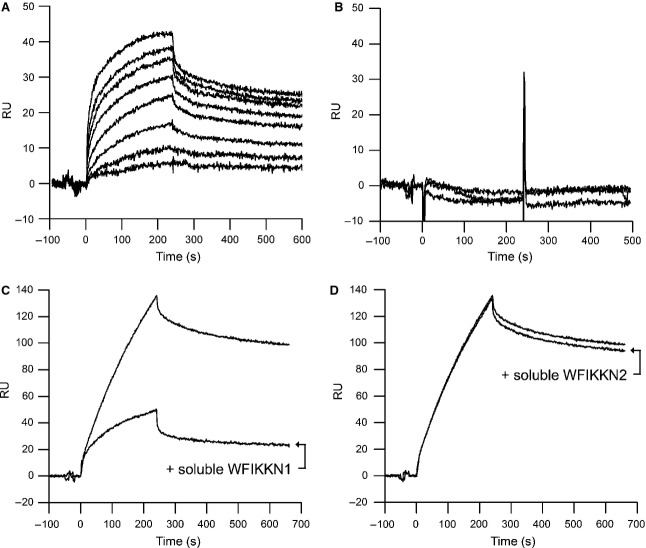Fig 7.
Interaction of myostatin prodomain with immobilized WFIKKN1 and WFIKKN2. (A) Sensorgrams of the interactions of myostatin prodomain (25, 50, 100, 200, 350, 500, 750, and 1000 nm) with WFIKKN1. (B) Sensorgrams of the interactions of myostatin prodomain (100, 500, and 1000 nm) with WFIKKN2. Various concentrations of myostatin prodomain in 20 mm Hepes, 150 mm NaCl, 5 mm EDTA and 0.005% Tween-20 (pH 7.5) were injected over CM5 sensorchips containing immobilized WFIKKN1 or WFIKKN2. For the sake of clarity, the concentrations of myostatin prodomain are not indicated in these panels; in (A), the SPR response increased in parallel with the increase in myostatin prodomain concentration. The response curves were fitted with the 1 : 1 interaction model of biaevaluation 4.1, and the KD for binding of WFIKKN1 to myostatin prodomain was calculated to be 2 × 10−8 m (A). Note that WFIKKN2 did not bind myostatin prodomain (B). (C) Sensorgrams of the interaction of immobilized WFIKKN1 with 200 nm myostatin prodomain preincubated with or without 1 μm WFIKKN1. (D) Sensorgrams of the interaction of immobilized WFIKKN1 with 200 nm myostatin prodomain preincubated with or without 1 μm WFIKKN2. Mixtures of WFIKKN1 or WFIKKN2 with myostatin prodomain were incubated for 30 min in 20 mm Hepes, 150 mm NaCl, 5 mm EDTA and 0.005% Tween-20 (pH 7.5) before injection over CM5 sensorchips containing immobilized WFIKKN1. Note that soluble WFIKKN1 efficiently inhibited the interaction of myostatin prodomain with immobilized WFIKKN1 (C), whereas soluble WFIKKN2 had no effect on the interaction (D). RU - SPR Response Units.

